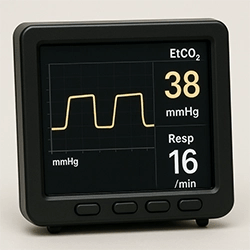Enroll in a CAPCE Bundle
Enroll in Individual Courses
AIRWAY COURSES
Capnography Basics, CAPCE 25-ACME-F3-0718
Basic – Airway – 1 CEH – Using capnography for assessing patient ventilation and status.
King Airway, CAPCE 24-ACME-F3-0108
Basic – Airway – .5 CEH – King Airway device function, indications, contraindications, and tips for insertion.
MEDICAL AND CARDIOLOGY COURSES
Anatomy and Pathophysiology of Stroke, CAPCE 23-ACME-F3-0531
Basic – Medical – .5 CEH – The impact of a stroke in the context of stroke screening and severity scales.
Basic EKG Fundamentals, CAPCE 24-ACME-F3-0122
Advanced – Medical/Cardiology – .5 CEH – EKG/ECG rhythm interpretation and time and energy measurements.
Diabetes Anatomy and Physiology, CAPCE 24-ACME-F3-0115
Basic – Medical – .5 CEH – The physiological factors, symptoms, types, and complications of diabetes.
Diabetic Emergencies, CAPCE 24-ACME-F3-0114
Basic – Medical – .5 CEH – Interventions and treatments for patients with diabetic emergencies.
EMS Management of Acute Coronary Syndromes, CAPCE 24-ACME-F3-0113
Basic – Medical/Cardiology – .5 CEH – ACS management from symptom onset to definitive care and transport.
Identifying LVO Strokes With FAST-ED, CAPCE 25-ACME-F3-0302
Basic – Medical – .5 CEH – Using the FAST-ED steps plus key priorities in stroke patient assessment and care.
Identifying STEMIs With 12-Lead ECGs, CAPCE 24-ACME-F3-0112
Advanced – Medical/Cardiology – .5 CEH – Interpreting ECGs to identify an ST elevation myocardial infarction.
IM Epinephrine (1mg/mL), CAPCE 25-ACME-F3-0324
Basic – Medical – .5 CEH – Indications, effects, and use of IM epinephrine for anaphylaxis and bronchospasm.
Large Vessel Occlusion Stroke, CAPCE 23-ACME-F3-0516
Basic – Medical – .5 CEH – Stroke screening, documentation, and communication with receiving stroke centers.
Sepsis: Recognize and Respond, CAPCE 24-ACME-F3-0103
Basic – Medical – .5 CEH – Sepsis identification and treatment options in the prehospital setting.
Stroke: EMS Transport Options, CAPCE 23-ACME-F3-0613
Basic – Medical – .5 CEH – Responding to stroke patients with appropriate treatments and transport decisions.
The Opioid Overdose Epidemic in America, CAPCE 24-ACME-F3-0101
Basic – Medical – .5 CEH – Identifying an opioid overdose patient and treating with Narcan to prevent mortality.
The ResQCPR System, CAPCE 25-ACME-F3-0814
Basic – Medical/Cardiology – .5 CEH – Essentials for using the ResQCPR System and performing ACD-CPR with an ITD.
…The ResQPOD ITD 10, CAPCE 25-ACME-F3-0815
Basic – Medical/Cardiology – .5 CEH – Using the ResQPOD and performing ACD-CPR with an ITD on patients in cardiac arr…
OPERATIONS AND EMERGENCY PREPAREDNESS COURSES
Landing Zone, CAPCE 24-ACME-F3-1214
Basic – Operations – .5 CEH – Facilitating a HEMS response and landing to bring your patient to definitive care.
Mass Casualty Incident – Module 1, CAPCE 24-ACME-F3-0809
Basic and Advanced – Operations – 1 CEH – An emergency preparedness course on MCI command and management.
Mass Casualty Incident – Module 2, CAPCE 25-ACME-F3-0123
Basic and Advanced – Operations – 1 CEH – An emergency preparedness course on MCI tactical and task response.
Radio Communications for EMS, CAPCE 24-ACME-F3-0104
Basic – Operations – .5 CEH – Effective radio communication between EMS providers and ED staff.
Violence in EMS: Recognize and Respond, CAPCE 24-ACME-F3-0106
Basic – Operations – .5 CEH – An EMS personnel plan for defense and the de-escalation of emerging threats.
PATIENT ASSESSMENT COURSES
Part 1: The Scene Survey, CAPCE 24-ACME-F3-0318
Basic – Patient Assessment – .5 CEH – Identifying scene subcomponents and needed resources to render proper care.
…Part 2: The Initial Assessment, CAPCE 24-ACME-F3-0319
Basic – Patient Assessment – .5 CEH – How to recognize and respond to potential life-threatening conditions.
Part 3: The Secondary Assessment, CAPCE 24-ACME-F3-0320
Basic – Patient Assessment – .5 CEH – Indications and components of focused, rapid, and detailed physical examination…
PREPARATORY COURSES
A Roadmap to Physical Patient Restraint, CAPCE 25-ACME-F3-0303
Basic – Preparatory – .5 CEH – Physical restraint procedures for resistant and combative patients.
Bed Bugs, CAPCE 24-ACME-F3-0120
Basic – Preparatory – .5 CEH – Bed bug identification, infestation, risks, and actions for mitigating transport.
Circadian Rhythm Disturbances, CAPCE 24-ACME-F3-0118
Basic – Preparatory – .5 CEH – The circadian rhythm, stages of sleep, and consequences of sleep disruptions.
Communicable Diseases Part 1, CAPCE 24-ACME-F3-0116
Basic – Preparatory – .5 CEH – Communicable disease pathogens, symptoms, and modes of transmission.
Communicable Diseases Part 2, CAPCE 24-ACME-F3-0117
Basic – Preparatory – .5 CEH – Communicable disease transmission and precautions for minimizing exposure.
Cot Operations: Patient Lifting, CAPCE 25-ACME-F3-0301
Basic – Preparatory – .5 CEH – Lifting biomechanics and tools for reducing injury and increasing patient safety.
Keep It Clean, CAPCE 24-ACME-F3-0109
Basic – Preparatory – .5 CEH – Fomites and the role of disinfection in preventing disease transmission.
Mental Wellness for EMS Providers, CAPCE 25-ACME-F3-0530
Basic – Preparatory – 1 CEH – Stress and trauma in EMS and strategies for resilience and recovery.
Patient Lifting and Handling, CAPCE 24-ACME-F3-0105
Basic – Preparatory – .5 CEH – Injury prevention using proper lifting practices, tools, and new technology.
SPECIAL CONSIDERATIONS COURSES
Introduction to the MI-MEDIC: Part 1, CAPCE 24-ACME-F3-0110
Advanced – Pediatric Medication – .5 CEH – How to use the Michigan Medication Emergency Dosing and Intervention Cards…
Introduction to the MI-MEDIC: Part 2, CAPCE 24-ACME-F3-0111
Advanced – Pediatric Medication – .5 CEH – Using the MI-MEDIC to answer the question: “How much do I push?”
TRAUMA COURSES
ACS Guidelines for Field Triage, CAPCE 24-ACME-F3-0121
Basic – Trauma – .5 CEH – Using the Trauma Triage Decision Making Scheme to meet trauma patient needs.
Burn Basics, CAPCE 24-ACME-F3-0119
Basic – Trauma – .5 CEH – Burn types, their effects, appropriate treatments, and transport considerations.
Platinum 600, CAPCE 24-ACME-F3-0107
Basic – Trauma – .5 CEH – Efficient and effective treatment plans in the first 600 seconds of a trauma.
Spinal Immobilization – Maybe It's Time for a Change, CAPCE 24-ACME-F3-0102
Basic – Trauma – .5 CEH – The dangers of backboard use for immobilizing patients with spine injuries.







































